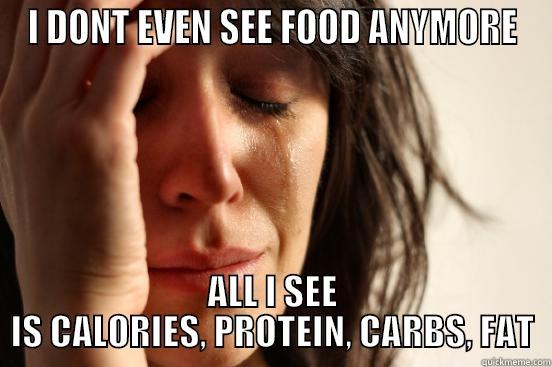6 Nutrition Tips to Follow When You Don’t Want to Count Calories
There are many things I’d rather do than spend my days meticulously counting calories. I understand its importance given certain individual’s goals. Whether it’s to shed “x” pounds of fat or maybe for health related reasons, counting calories is often a necessity for some people.
That said, speaking personally, and in no specific order, I’d rather…
- Talk about me feelings
- Get a face tattoo
- Attend another parent’s kid’s clarinet recital
…than count calories.
My feelings and preferences don’t matter much in this scenario, however. Today’s guest post by Toronto based coach and nutritional practitioner, Marc Capistrano, helps to shed some light and offer a few bonafide nuggets of practical advice for those who are kinda in the same boat as myself, but would rather refrain from the face tattoo.
Enjoy!

Copyright: dolgachov / 123RF Stock Photo
6 Nutrition Tips to Follow When You Don’t Want to Count Calories
If you’ve ever been around a group of people talking about nutrition, then you’ve probably found yourself caught in the middle of a debate between the macros crowd (people who count macros and calories) and the “every other diet in the world” crowd.
Here’s what a typical argument in the gym locker room probably sounds like:
Bro #1: “Bro, in order to get ripped, you need to go keto, cut carbs, then at night go vegan.”
Bro#2: “Bro, it doesn’t matter what you eat, as long as you’re in a caloric deficit.”
Bro #1: Bro.
From a macros standpoint, the idea is that whether you’re following a keto, low carb, paleo or dim sum diet, you’re basically manipulating macros that either put you in a caloric deficit or surplus.
This is the foundation of weight loss and weight gain.
There’s definitely more to this statement (including food quality, digestion, and hormonal profile), but for the purposes of this post, let’s just stick with the basics and agree that counting macros is the most sustainable (depending on who you talk to) and precise way of gaining or losing weight.
However, what if you find weighing your food time consuming and you’re simply looking for a set of habits that keep caloric intake modest without having to carry your food scale with you everywhere you go.
The thing is, there are a lot of us that don’t want to spend our time counting calories and weighing our food.

With that being said, here are a couple of rules to implement that can naturally keep your caloric intake modest and consistent.
1. Prioritize Protein and Vegetables
The good thing about protein and vegetables is that it’s hard to overeat on these foods.
For the majority of us, we can all agree that it’s harder to overeat on a steak and some veggies than it is with a bowl of pasta or pizza. Not only does protein and veggies offer more volume of food without a crazy amount of calories, but they also provide the body with amino acids and fiber (both essential to the body).
A general guideline is to eat about a palms size of protein at each plate along with 1-2 fists worth of veggies at each meal.
2. Lift Heavy Things
This is especially important to implement on days where you know you’re going to eat something heavy/calorically dense.
Movements like squats and deadlifts promote insulin sensitivity (this makes our body more efficient at utilizing carbohydrates when we eat them).
Regular exercise creates “more space” calorically.
Think about it like paying your credit card off before making another big purchase. If you’re really dedicated, try implementing your own routine before heavier meals.
Maybe 100 Kettlebell Swings before the buffet?
3. Let Your Activity Level Dictate Your Carbohydrate Intake
This rule is simple.
If you’re not as active on one day, then there’s no need for as many carbs.
I always think of carbs as an expensive fuel. When we need to run the body like a Ferrari (think high performance), then put the expensive fuel in. Otherwise running primarily on veggies, fat, and protein is as efficient as running the body like a hybrid car.
Disclaimer: There are a lot of benefits to increasing carbohydrate intake (especially from a recovery standpoint), so don’t think carbs are inherently bad, we just don’t need as many as people think (especially when activity levels don’t warrant it)
4. Make Alcohol and Refined Sugar a Luxury
I’m not suggesting you cut these foods out, but instead, make it worth it when you do consume these things.
That means instead of wasting your carbs on low-quality sugar during the week, opt to save your carbs for a time where you’re at a restaurant that’s known for their sourdough bread or pasta.
Another example is alcohol.
Instead of having a beer at home by yourself while watching 90-Day Fiancé and arguing with the TV, save it for a time when you’re out with friends and make alcohol an experiential thing.
The reason for this is that these things are easy to over-consume. Placing limitations on these things make it easier to keep intake moderate.
5. Drink More Water
This nutrition tip is an overused one, but it’s an important one.
Weight loss in relation to drinking more water works on a couple of levels.
Hydrating with water promotes more satiety; it’s essential to overall body metabolism function and it also supports your performance in the gym. A general rule thumb when buying an expensive double vacuum sealed water bottle is to buy three because you’re bound to lose the first two in one month (speaking from personal experience).
6. Sleep as Hard as You Train
Our metabolism determines how effective our body is at taking in and expending calories.

Someone needs to write a version FOR adults
Sleep is the process that up-regulates body metabolism along with many other hormonal processes. Sleep helps maintain fat-free body mass and can make fat loss difficult to achieve despite being in a caloric deficit.
Before You Troll Me…
Before the hate starts in the comments section, let’s make something clear.
These principles are not bulletproof.
Despite following all these rules, you can still screw things up as far as caloric intake goes. These rules simply provide some structure that provides you with a buffer from the effects of overeating. If you have specific body composition goals or are eating for performance, then I highly suggest you quantify your food by hitting specific macro and caloric goals.
Even if this isn’t something you want to do long term, there is still some benefit in having a rough idea of what food looks like calorically at each meal.
About the Author
 Marc Capistrano is a Certified Nutritionist, fitness enthusiast, and content creator. He currently works out of downtown Toronto and maintains the Live It Holistic Nutrition blog. His work has been featured on CBC Life and Stack Magazine. As a University of Toronto graduate, he completed his BA and went on to achieve his Certified Nutritional Practitioner (CNP) designation in 2016. Marc is also a self-proclaimed buffet connoisseur and listener of Drake.
Marc Capistrano is a Certified Nutritionist, fitness enthusiast, and content creator. He currently works out of downtown Toronto and maintains the Live It Holistic Nutrition blog. His work has been featured on CBC Life and Stack Magazine. As a University of Toronto graduate, he completed his BA and went on to achieve his Certified Nutritional Practitioner (CNP) designation in 2016. Marc is also a self-proclaimed buffet connoisseur and listener of Drake.
Website: www.liveitholistic.com
YouTube: HERE
Instagram: HERE



Comments for This Entry
Best Fitness Articles From The Previous Week: November 24 2019 -
[…] 6 Nutrition Tips To Follow When You Don’t Want To Count Calories: Courtesy of Marc Capistrano on […]November 22, 2019 at 5:36 am |